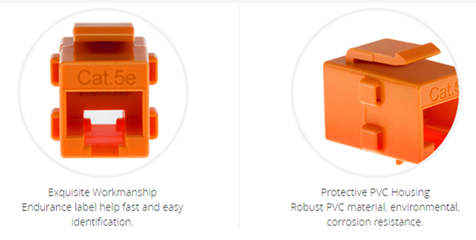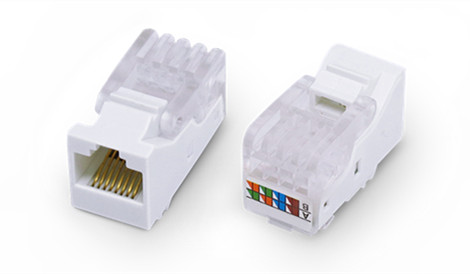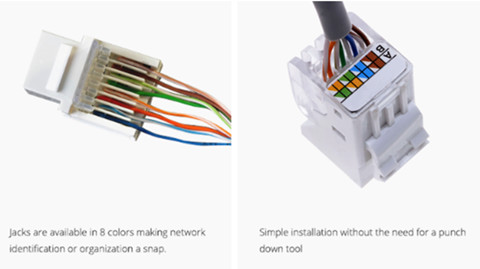When DIY a home network, besides the common problems (written in the previous article “Do It Yourself for Your Home Network”), people often feel puzzled about what I should use for my jacks—inline coupler or punch down keystone jack. The first one is easy to install but adds an extra connection to the network. The last one is more cheaper and needs a punch down tool to complete the installation. Today’s article will continue to illustrate the technical differences between them, please read on.
What Is Inline Coupler?
Before we come to the comparison between inline couplers and keystone jacks, let’s have a brief overview of these two jacks. A small device for connecting two cables to make a linger cable, usually called an inline coupler or RJ45 coupler. Inline couplers do not provide any amplification or signal boost, and can cause attenuation and signal degradation unless they are of high quality. There are cat5e and cat6 RJ45 inline couplers available on the market.

Figure 1 shows the Cat5e RJ45 inline coupler (orange). This Cat5e Coupler offers a practical, cost-effective solution for joining two RJ45-terminated cables together to form one long cable.
What Is a Keystone Jack?
Keystone jacks are the standardized snap-in packages for mounting a variety of low-voltage electrical jacks or optical connectors into a keystone wall plate, faceplate, surface-mount box, or a patch panel. As displayed in the Figure 2, keystone jacks have a rectangular face of 14.5mm wide by 16.0mm high and are held in place with flexible tabs. This allows them to be snapped into a mounting plate with correspondingly-sized rectangular holes, called ports.

All keystones, regardless of the type of jack they carry, are interchangeable and replaceable. This provides much flexibility in arranging and mounting many different types of electrical jacks in one plate or panel without requiring customized manufacturing.
Some keystones use a pass-through type connector, where there is a jack on both the front face as well as the rear side. Others only have a jack on the front and employ a different mechanism for hard-wiring signal cables to the rear, such as a mini 110 block, an insulation-displacement connector, or a crimp or solder connection.
Whether Should I Use Inline Coupler or Punch Down Keystone Jacks
If you go with inline couplers, you should be aware that they might work well but can turn flaky for a while owing to the plug oxidation or loose fit. RJ45 couplers are easy to install, but they probably will increase the line resistance of the whole total cable length slightly which would decrease the max length of the allowed run (from ~328 feet for 100mb and ~300 feet for gigabit on cat5e by 10-20ft per coupler/patch). However, this will not have any noticeable affect on network performance for a home network unless you are on the limits of the specs.
Note: If you have speed certified network (probably not at home, but possibly in a high-tech office) then you are not allowed to use couplers.
Punch down keystone jack is usually cheaper than the RJ45 coupler, but more difficult to install. As the punch down is more prone to human error, so not only is it hard to install, but if you have issues, it'll also be hard to reinstall. Therefore, the toolless keystone jacks have been introduced on the market, which make for a simple installation without the need for a punch down tool. Of course, the price is much higher than that of the Punch down keystone jack.

Figure 3 shows the cat6 toolless keystone jacks.
To sum up, if all the connectors are done right, there are really no any obvious differences in signal whether you use the Inline couplers or punch down keystone jacks for connection. It's all a question of how reliable the physical connections can be. However, sometimes the couplers can have issues inside the cube where they just stop working over time. You'd then have to replace it, which indeed will be a faster replacement than a punch down. But after its replaced, things should be back to normal.
Conclusion
Keystones jacks are quite versatile and can be mounted easily into a wall plate. While inline couplers also play an important role in the overall system. If you are planning on expanding your home network in the next few years, you should know which type of the jacks that allow you to connect the devices safely and securely. FS.COM offers cost-effective RJ45 couplers and toolless keystone jacks such as cat5e coupler, cat6 coupler, cat5e toolless Keystone Jack, cat6 toolless Keystone Jack, etc. If you have any doubt, please feel free to consult us.

Thank you for sharing the information.
ReplyDeletePassive Networking
Structured Cabling